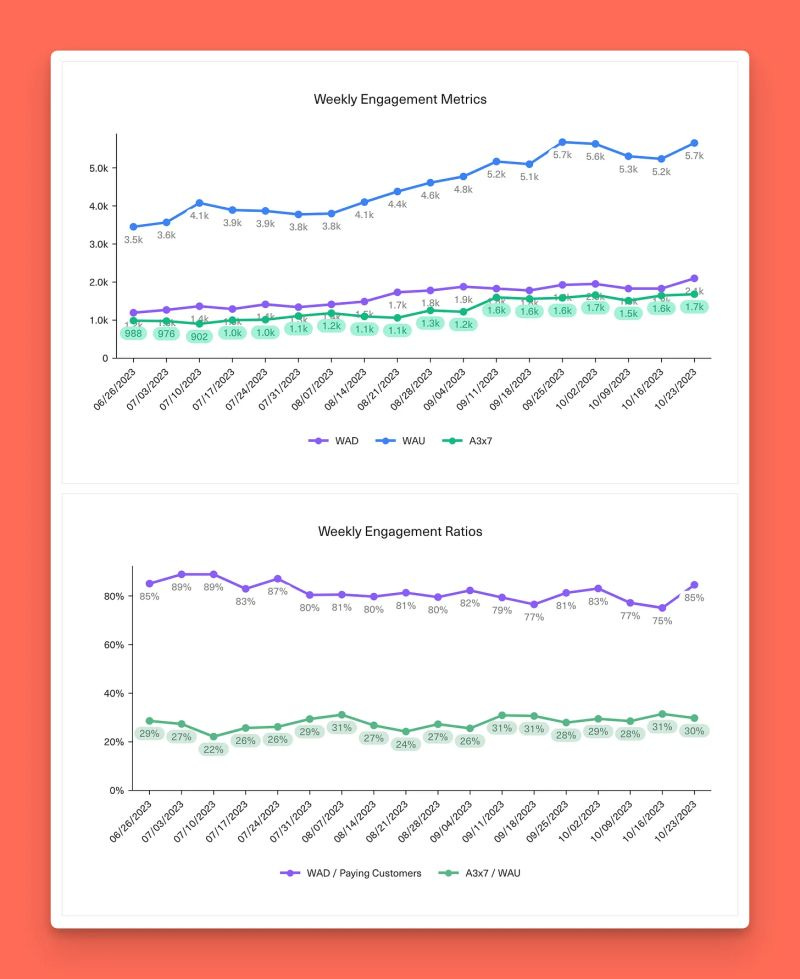My favorite engagement metric, A3x7
How many users are active 3 out of 7 days a week?
When I think about the job of the first operator, I usually default to the obvious stuff. ARR. CAC. Payback periods. Net dollar retention. Pipeline coverage. Those are the numbers that show up in the board deck and get debated in amongst leadership.
Yet finance teams tend to think a whole lot less about engagement metrics. At least I did. And that’s what I quickly want to get into today.
David Sacks wrote a great post on this a while back.
His point was simple: engagement is a leading indicator for retention. If people aren’t coming back to your product, your revenue models will eventually collapse.
The problem is the metrics we borrowed from consumer products don’t always fit SaaS neatly. DAU, WAU, MAU, DAU/MAU. They’re fine, but they’re messy. Weekends drag down the averages. Freemium users create noise. And engagement looks completely different across accounts.
Sacks’ advice was to adjust the lens. Focus on weekdays. Strip out free users. Look at the top accounts. That’s where you really see what “good” looks like.
Over the years I’ve put my own twist on this. It started back at Intercom. Paul Adams, our VP of Product who had just come from Facebook, used to ask me to measure how many users were active 5 out of 7 days a week. His thinking was: if people are in the product basically every workday, then we’re building a habit. That’s a sign of deep product-market fit.
That framing stuck with me. These days my favorite engagement metric is what I call A3x7. How many users are active at least 3 out of 7 days a week.
It’s not perfect. I adjusted it down slightly from A5x7 because I felt like every workday felt a bit too much of a high bar for an enterprise tool. But it’s a much higher bar than MAU or WAU. It shows you who really lives in the product. Who can’t do their job without it. It’s close to approximating what Sacks’ says is good - 60% DAU / WAU (assuming that they’re active really 3 out of 5 eligible work days in a week).
Why this matters: engagement is one of the very best early indicators of whether a company is going to work.
If you gave me the choice between:
a company with industry-best engagement but no GTM figured out yet, or
a company with a strong GTM engine but weak engagement,
I’ll take the first one every time.
Because GTM you can figure out. Engagement you can’t fake. Without it, everything else falls apart.
And practically speaking, engagement data gives the operator a lot to work with.
In a board deck, it helps you tell the story: yes, revenue is still early, but look at how often people are using the product.
In a GTM conversation, it helps prioritize: which customer profiles are most engaged, and how do we sell to more of them?
In product, it helps drive focus: what’s working for power users, and how do we replicate it across all users?
That’s why I think engagement belongs right next to ARR and NDR on your dashboard. It’s the bridge between product and finance. It tells you whether the revenue model you’re building actually has a foundation.


